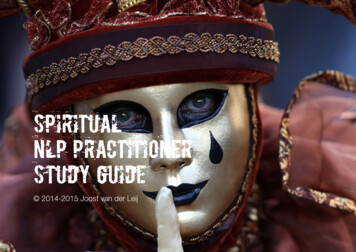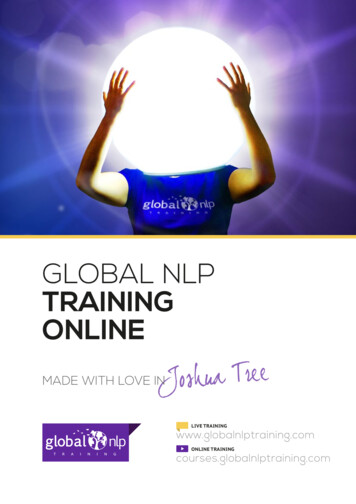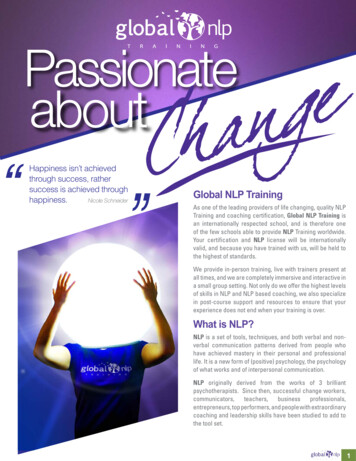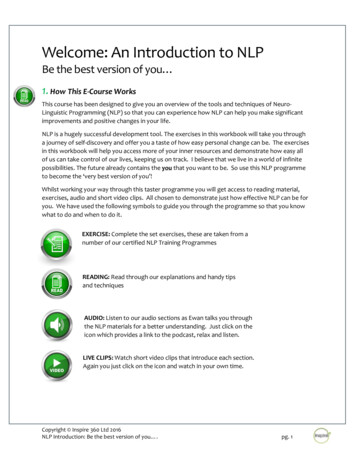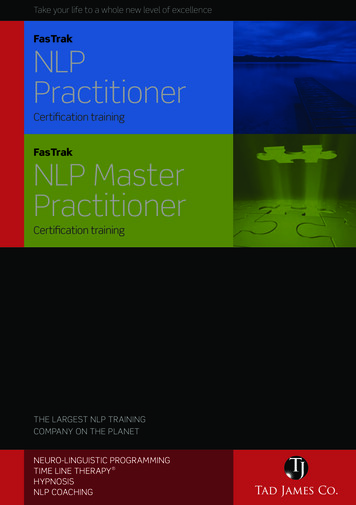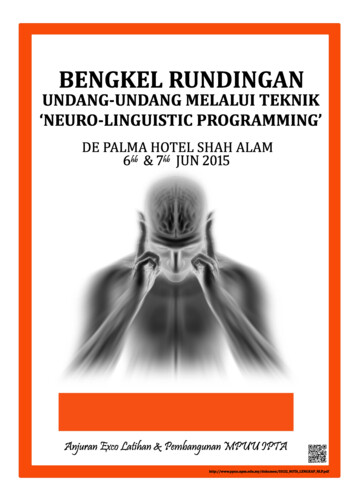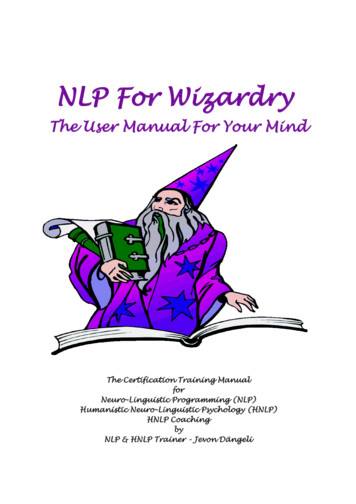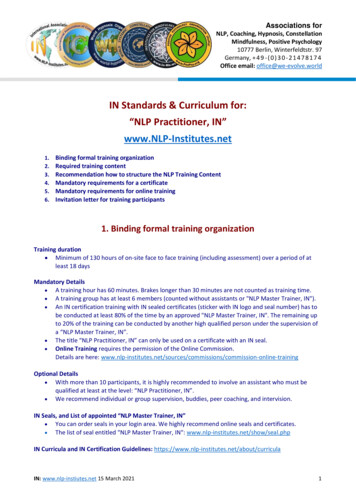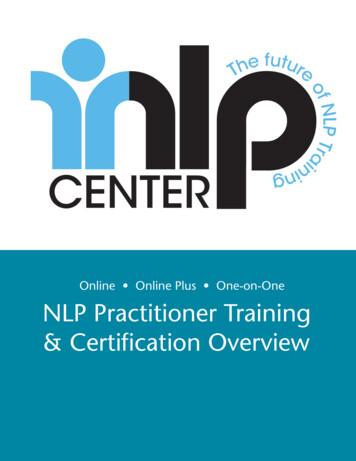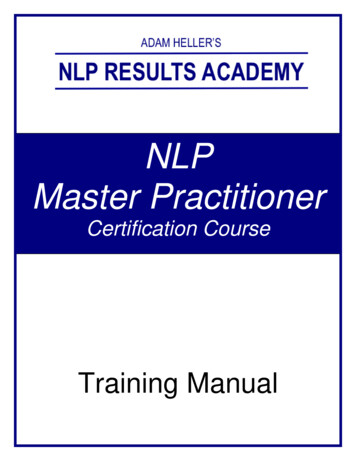
Transcription
NLPMaster PractitionerCertification CourseTraining Manual
Training ManualMaster PractitionerCertification CourseBy Adam Heller 2014Coach Heller LLCPO Box 4948Laguna Beach, CA949-497-8383http://NLPResultsAcademy.comThis Manual Belongs To:Copyright 2014 – Coach Heller LLC1
Welcome to Your Training!Greetings and welcome to your NLP Results Academy NLP Master Practitioner Training.NLP is a large body of knowledge primarily concerned with how to achieve excellence.You can read a complete definition and description of NLP a few pages further on in thismanual. To make the training process more effective, we will be teaching NLP to you indigestible ‘chunks.’In the Practitioner Module of this training course, we focused on providing you with theinformation and interventions that make up the foundations of NLP. In this MasterPractitioner section, we will present you with advanced concepts and interventions thenfinally bring all the pieces together in a way that will prepare you to help individualclients make behavioral changes to achieve excellence in their lives.Training Chunks and FlowPractitioner ModuleInformationInterventionsMaster Practitioner ModuleAdvancedInterventionsBringing it allTogetherCopyright 2014 – Coach Heller LLC2
Table of ContentsTitle Page .1Welcome to Your Training!.2Table of Contents .3Introduction to NLP .5Short Definition of NLP.6Questions & Answers about NLP .7NLP Communication Model.9Cause & Effect .10Responsibility for Value .11How to Get Certified.12Values.13Values Sources .14Values Elicitation.15Values Alignment .16Values Elicitation.17Changing Values .18Sub-Modalities Evaluation.19Basic Meta Programs .20Meta Programs .21Meta Programs Inventory .26Parts.28Parts Integration .29Meta Model III .30Copyright 2014 – Coach Heller LLC3
Week 2The Spin .31Phobia Destroyer.32Compulsion Blowout .34Rapid Timeline Breakthrough (RTB) .35RTB First Ride on the Timeline.36RTB Discovering the First Time.37RTB Releasing Negative Emotions .38Basic Reframes .40RTB Temporal Decision Destroyer .41RTB Change Personal Identity .43Week 3RTB Grief Process .45NLP Change Structure .46What is a Client? .47Couples / Family Therapy Model .48Rapid Life Change Breakthrough Pre-Session .52Rapid Life Change Breakthrough Session.52Client Personal Background .53Client Personal Data.57Pre-Coaching Puma.58Week 4Adding Positive Resources .59Appendix .61Copyright 2014 – Coach Heller LLC4
Introduction to NLP(Neurolinguistic Programming)Welcome to the world of NLP. Neurolinguistic Programming is the systematic study ofhuman performance. NLP is a practical application of how people think. This study ofthe structure of the subjective experience can be broken down into their smallestcomponents (or chunks) and changed, modified, improved upon, or removed. Thisallows a framework for growth and change at much deeper levels more quickly than wasoriginally thought.NLP was developed through the efforts of several people. Some of the more notablenames are Leslie Cameron-Bandler, Steve and Connirae Andreas, Robert Dilts, RichardBandler, John Grinder, and many others. Their studies began in the 1970’s and havecontinued to grow to the present. NLP techniques enable therapists to be much moreeffective in assisting change in their clients lives. Neurolinguistic Programming broughtabout the ability to analyze and transfer human excellence, thus resulting in the mosteffective and practical psychology known.NLP is based on the work of several people whom the above-mentioned studied. Theyinclude Alfred Korzybski, Virginia Satir, Milton Erickson, Fritz Pearls and GregoryBateson, among others. They were chosen as excellence to model.This is a hands-on learning experience. Keep an open mind and be willing to allow thetraining to work with you at all levels.(Please note that this manual is meant as a companion, supplement, and reference to thecourse, not an exact duplication of the videos/DVDs. Some exercises may not appear inthe exact order the class is taught. Please reference the table of contents for pagenumbers.)Copyright 2014 – Coach Heller LLC5
Short Definition of NLPNeuro:The nervous system (the mind), through which weinteract with the external world to receive and processexperiences through the five senses: Linguistic:Language and other nonverbal communication systemsthrough which our neural representations are coded,ordered and given meaning. Includes: atoryPicturesSoundsFeelingsTastesSmellsWords (Self Talk)The process of how we run our internal programs toachieve specific outcomes.Copyright 2014 – Coach Heller LLC6
Questions & Answers about NLPQ.What is NLP?A.NLP is a unique model of how people learn, motivate themselves, andchange their behavior to achieve excellence in any endeavor.Q.How did NLP get its name?A.The term Neurolinguistic Programming was introduced by AlfredKorzybski. This is also the same man who quoted, “God may forgive youfor your sins but your nervous system won’t." NLP is an integration ofseveral disciplines including neurology, psychology, linguistics,cybernetics, and systems theory. The components of the termNeurolinguistic Programming describe best what this little known scienceencompasses. NEURO because all of our experiences, both conscious andsubconscious, are derived through and from our senses and centralnervous system. LINGUISTIC because our mental processes are also coded,organized, given meaning and transformed through language. PROGRAMMING because people interact as a system in whichexperience and communication are composed of sequences ofpatterns or “programs.”In NFNLP, we currently use PSYCHOLOGY rather than Programming.We do this because the word Psychology comes from the word “psyche”meaning “Spirit” and “ology”, the “study of systems.”Copyright 2014 – Coach Heller LLC7
Q.What can NLP do?A.It lets you model, or copy, human excellence in any form. With NLP, youcan identify what makes someone exceptionally skilled, and get that skillfor yourself or teach it to others. NLP can help you become adept inwhatever is important to you, whether that means getting along with yourfamily and coworkers or being more effective on the job.Q.Where is NLP useful?A.NLP is valuable wherever human communications skills can enhanceresults – in business consultation, management, negotiation, education,counseling, therapy, relationships, parenting, nursing, public speaking,sports performance and many other areas.Q.What kind of results can I get with NLP?A.NLP can allow a therapist to change the impact of the past on a client, ateacher to change a poor speller into a good speller, a business person togain rapport non-verbally and run meetings efficiently, an athlete toimprove concentrations, and more.Q.Is NLP a therapy?A.Although NLP can be used as a method of therapy, the applications aremuch broader. Even when used as a therapy, it’s basically a process ofteaching people how to use their brains. Most therapy is remedial; that is,directed towards solving problems from the past. NLP goes much furtherto study excellence and teach the skills that promote positive change thatgenerates new possibilities and opportunities.Copyright 2014 – Coach Heller LLC8
NLP Communication Model& Internal RepresentationsBrain processes only134 bits per second,in 7 /- ChunksOurExperienceVAKOGSenses take in2,000,000bits per second ofinformation.BWords usedto label ourexperience.Copyright 2014 – Coach Heller LLC9
Cause & EffectC EResultsReasonsExcusesVictimWhich SideDo You Choose?Copyright 2014 – Coach Heller LLC10
Responsibility for ValueNo matter what you do, what you purchase or otherwise acquire, it’s up to you to get thevalue that’s available.When you: hire a coach or therapist rent a hotel room. purchase a TV. go a restaurant. take a training. or anything else you might do, it’s always up to you!Copyright 2014 – Coach Heller LLC11
How to Get CertifiedThis training offers you certification as a Master Practitioner of NLP. There isno secret as to how to earn your certification. We want you to succeed andyou will – as long as you do all of the following things: Watch and pay attention to all videos Follow along with the videos making notes in this Manual. Fill out your Master Practitioner exam as you go along. Practice techniques and interventions outside of class Read and absorb all companion material Be curious and willing to ask questionsCopyright 2014 – Coach Heller LLC12
ValuesDefinitionsValues:That which is important to you.Highly Valued Criteria:Your most important values.Beliefs:The principles/opinions you trust as being true.Ideas that have been reinforced over a period of time until you believe them to be true.Attitudes:The values and beliefs that you hold around subjects. Values Beliefs AttitudesStructure of Values HierarchyCopyright 2014 – Coach Heller LLC13
Values SourcesWe are influenced to adopt values from many, many different sources around us. Theseare among the primary sources, but there are many others.FamilyChurch / ReligionFriendsSchoolPoliticsGeographyCulture / SocietyExpertsBusinessMediaCopyright 2014 – Coach Heller LLC14
Values ElicitationValues should be elicited in context.1. What’s important to you about ?Values Contexts:A.B.C.D.E.F.G.H.I.Family / FriendsWork / CareerIntimate RelationshipsHealth / Well-beingSpiritualityFun / LeisureHome / EnvironmentSociety / CultureOther?2. What else is important to you about ?3. What else is important to you about ?4.Number the values according to their importance.What's the most important? What's next, etc. (If needed, use questions below.)A. Of the above values, which is the most important to you?B. Assuming you have (list values already chosen), is ormore important to you?C. Assuming you have (list values already chosen), if you couldn’t havebut you could have , would that be OK?(If the client has trouble answering, then make sure that they are in a decisivephysiology.)5. Re-write your list of values in order of their importance to you.Values Threshold(Use values just elicited.) With all these values present, is there anything that would cause you to leave? With all these values present, is there anything that would cause you to stay?Copyright 2014 – Coach Heller LLC15
Values AlignmentAlignment Tests1. Motivation DirectionIs the underlying motivation (or value) what is wanted or what is not wanted? Lookfor:a. Negationsb. Comparative deletionsc. Modal Operators of Necessity2. Toward-Away conflictsSequential incongruity3. Toward-Toward conflictsSimultaneous incongruity4. Away-Away conflictsSimultaneous & Sequential incongruityCopyright 2014 – Coach Heller LLC16
Values ElicitationWhat is important to you aboutCareer, Relationships, Family, Health and Fitness (living), Personal Growth, SpiritualityWrite Client ValuesValues Re-ordered by Client1.2.3.4.5.6.7.8.9.10.Threshold (context)All these values being present, is there anything that could happen that would make youleave or stop? Keep asking until empty.All these values being present, plus (value-s- just mentioned) what would have to happento make you stay?Alignment / Conflict CheckToward – Away:Toward – Toward:Away – Away:Copyright 2014 – Coach Heller LLC17
Changing ValuesChange the Values Hierarchy1. Identify the value to change in order within the hierarchy (value X).2. Identify the value (value Y) just above where you want to move value X.Value YValue X3. Elicit Sub-Modalities of value X.4. Elicit Sub-Modalities of value Y5. Match Sub-Modalities of value X to value Y.6. Make one or two minor changes downward to the Sub-Modalities of value X.(Example, reduce brightness of value X and make it slightly smaller.)Value YValue XCopyright 2014 – Coach Heller LLC18
Sub-Modalities EvaluationWorksheetUse the characteristics below to evaluate and determine sub-modalities.Visual1234Color / Black & WhiteDistance - Near / FarBright / DimLocationSize of PictureFocused / DefocusedFocus (Changing/Steady)Associated / DissociatedFramed / PanoramicMovie / StillMovie-Fast/Normal/SlowContrast – High / LowDimension - 3D / FlatPerspective – View AngleAuditoryLocationDirectionInternal / ExternalLoud / SoftFast / SlowPitch – High / LowTone & TimbrePausesRhythmic / IrregularDuration – Long / tensity & DurationSteadyVibrationWeightCopyright 2014 – Coach Heller LLC19
Basic Meta ProgramsMyers Briggs1. External BehaviorWhen it’s time to recharge your batteries, do you prefer to be alone or with people?A. IntrovertB. Extrovert2. Internal ProcessIf you were going to study a certain subject, would you be more interested solely inthe‘ facts and their application for the now, or would you be more interested in theideas and relationships between the facts and their application for the future?A. SensorB. Intuitor3. Internal StateWhen you make a decision do you rely more on impersonal reason and logic, or moreon personal values?A. ThinkerB. Feeler4. Temporal Operator (Time)Do you use a Daytimer or Smart Phone calendaring system? Do you use it regularly?Do you enjoy it? or — Why did you buy your last car?A. JudgerB. PerceiverCopyright 2014 – Coach Heller LLC20
Meta Programs1. Direction ProgramWhat do you want in a (car/job/relationship)?What’s important to you about ?A. TowardB. Toward with a little AwayC. Both Toward and Away equallyD. Away with a little TowardE. Away2. Reason ProgramWhy do you choose to do what you’re doing?A. PossibilityB. NecessityC. Both3. Frame Of Reference ProgramHow do you determine when you’ve done a good job?A. InternalB. ExternalC. Internal with External CheckD. External with Internal CheckCopyright 2014 – Coach Heller LLC21
4. Convincer Internal Representation ProgramHow do you know when someone else is good at what they do?A. SeeB. HearC. DoD. Read5. Convincer ProgramHow often does someone have to demonstrate competence to you before you’reconvinced?A. AutomaticB. Number of TimesC. Consistent6. Management Direction ProgramDo you know what you need to do to be a success on a job?Do you know a good way for someone else to increase his/her chances?Do you find it easy or not so easy to tell them?A. Self and OthersB. Self OnlyC. Others OnlyCopyright 2014 – Coach Heller LLC22
7. Action ProgramWhen you come into a situation do you tend to: Size it up, then act quickly? Do a complete study of all the consequences and then act?A. ActiveB. ReflectiveC. BothD. Inactive8. Primary Interest ProgramWhy is your favorite restaurant your favorite? .A. PeopleB. PlaceC. ThingsD. ActivityE. Information9. Chunk Size ProgramIf we were going to do a project together, would you want to know the big picturefirst, or the details? Once you know that, do would you really need to know the other?A. SpecificB. GlobalC. Specific to GlobalD. Global to SpecificCopyright 2014 – Coach Heller LLC23
10. Relationship ProgramWhen you come into a new situation, do you usually notice the similarities first or thedifferences first?A. SamenessB. Sameness with ExceptionC. Sameness and Differences EquallyD. Differences with ExceptionE. Differences11. Time Storage ProgramRecall a memory from the past (future). From what direction does that memorycome? Point in that direction.A. Through TimeB. In Time12. Modal Operator Sequence ProgramWhat was the last thing you said to yourself just before getting out of bed thismorning? (can, must, want to, got to, have to, should, etc.)13. Information Processing StyleWhen you need to solve a problem or overcome a challenge in your life, must you: Talk about it with someone else? Think about it by yourself only?A. ExternalB. InternalCopyright 2014 – Coach Heller LLC24
14. Listening StyleIf someone you knew quite well said to you, “I'm hungry,” would you tend to: Find the comment interesting, but take no action? Do something about it?A. LiteralB. Inferential15. Speaking Style*If you felt that someone around you was underperforming, would you: Tell them directly? Beat around the bush and hope they ‘get it’?A. LiteralB. Inferential* A Literal Listener may not know when an Inferential Speaker complements them.An Inferential Listener may think that any question is a request for action.Copyright 2014 – Coach Heller LLC25
Meta Programs InventoryMyers Briggs & Meta ProgramsMyers Briggs1. When it’s time to recharge your batteries, do you prefer to be alone or withpeople?2. If you were going to study a certain subject, would you be more interestedsolely in the‘ facts and their application for the now, or would you be moreinterested in the ideas and relationships between the facts and their applicationfor the future?IntrovertExtrovertSensorIntuitor3. Can you remember a work situation that gave you trouble, a specific onetime event? When you make a decision do you rely more on impersonalreason and logic, or more on personal values?Thinker4. Do you use a Daytimer or Smart Phone calendaring system? Do you use itregularly? Do you enjoy it? or — Why did you buy your last car?JudgerFeelerPerceiverMeta ProgramsDirection Program: What do you want in a job'? orWhat do you want in a relationship? orWhat do you want in a car? orWhat do you want to do with your life? orFor you, what's important about what you do?Reason Program:Why do you choose to do what you‘re doing?Frame Of Reference Program:How do you determine when you've done a good job?Convincer Internal Representation Program:How do you know when someone else is good a what they do?Convincer Program:How often does someone have to demonstrate competence to you before youare convinced?Management Direction Program. Do you know what you need to do to be a success on a job? Do you know a good way for someone else to increase his / herchances? Do you find it easy or not so easy to tell them?Copyright 2014 – Coach Heller LLCTowardToward/AwayBoth ExternalInt. w Ext.CheckExt. w Int. CheckSeeHearDoReadAutomaticTime(s)ConsistentSelf & othersSelf onlyOthers only26
ActiveAction Level Sort Program:When you come into a situation, do you tend to: Size it up then act quickly: Do a complete study of all the consequences then act?Primary Interest Program:Why is your favorite restaurant your ctivityInformationChunk Size Program:If we were going to do a project together, would you want to know the bigpicture first or the details? Once you know that, would you really need toknow the other?SpecificGlobalSpecific to GlobalGlobal to SpecificRelationship ProgramWhen you come into a new situation, do you usually notice the similaritiesfirst or the differences first?Time Storage ProgramRecall a memory from the past (future). From what direction does thatmemory come? Point in that direction.Modal Operator Sequence Program:What’s the last thing you said to yourself just before getting out of bed thismorning? (can, must, want to, got to, have to, should, etc.)Information Processing Style:When you need to solve a problem or overcome a challenge, must you: Talk about it with someone else? Think about it by yourself only?Listening Style:If someone you knew quite well said to you “I’m hungry,” would you tend to: Find the comment interesting but take no action? Do something about it?Speaking StyleIf you felt someone around you was under-performing, would you: Tell them directly? Beat around the bush and hope they ‘get it’?Copyright 2014 – Coach Heller LLCSamenessSame w exceptionsSame / Diff EquallyDiff with exceptionsDifferencesThrough alInferential27
PartsBasicsWhat are parts?1.Parts are individual parts of the unconscious with its own purpose / intentionand function / behavior.2.Parts are functionally detached from the rest of nervous system (nonintegrated).3.They often represent minor personalities (subpersonalities).4.Parts typically have their own values and beliefs.5.Some parts may think they’re responsible for maintenance of the system.6.Parts are born from Significant Emotional Experiences.7.The purpose is to protect and maintain a non-integrated behavior.8.Parts are a source of incongruence in the person.9.The parts themselves are incongruent.10. The incongruence lies in the difference between the purpose/intention &function/behavior.11. A part usually has its opposite, an alter ego, the flip side of the coin.12. These two parts will ultimately have the same highest purpose / intention.13. They were once a part of a larger whole.14. This makes possible the reintegration of the part back into the whole.Copyright 2014 – Coach Heller LLC28
Parts IntegrationCreated by Tad James1. Identify the conflict and the parts involved: Make sure you clearly identify the partsclearly, and understand the nature of the conflict.2. Have the Part, which represents the unwanted state or behavior come out on the handfirst: “I wonder if I can talk to this part. Which hand would it like to come out andstand on?” (Show client how to hold hand.)3. Make sure that the Client has a V-A-K image of the part as it comes out on the hand:“Who does this part look like; does it look/sound/feel like someone you know?”4. Elicit the “Opposite Number” to come out on the other hand: “I’d like to talk to thePart with which this Part is most in conflict, the flip side of the coin the oppositenumber, and let’s have it come out and stand on the other hand.” (Show client how tohold hand.)5. Make sure that the Client has a V-A-K image of the part as it comes out on the hand:“Who does this part look like; does it look/sound/feel like someone you know?”6. Separate intention from behavior: Reframe each part so that they realize that theyactually have the same intention by chunking up — ask, “What is the intention?” or“For what purpose?” (Begin chunking up first with the part that has the unwanted stateor behavior. As you do, make sure that the client’s intention stays associated.) Makesure that both parts get to the same word as highest intention.A. Now, have the parts notice they were once part of a larger whole.B. Ask for other parts that were also once part of the larger whole. Have them join inthe integration.C. What resources or attributes does each part have that the other part would like tohave?7. As the hands come together give additional suggestions for integration.8. Take the integrated part inside and have it merge into the wholeness inside.9. Test & future pace.10. Re-elicit the values to see if there is a change.Copyright 2014 – Coach Heller LLC29
Meta Model IIIDirected Questions for ChangeProblem:1. What's the problem?2. What caused this problem?3. How have you failed to resolve this problem?4. How can you overcome the solution to your problem?FlipSolution:5. What would you like to change?6. When will you STOP IT from being a limitation?7. How many ways do you know you have solved this?8. I know you are changing and seeing things differently.ConfirmCopyright 2014 – Coach Heller LLC30
The SpinCreated by Richard BandlerA phobic or negative sensation/emotion always starts somewhere in the body. In addition,the sensation generally also moves, rotating or spinning. The purpose of this intervention isto break the old pattern to free the client of their fear or negative emotion.1. When you think of (needles) where does the negative sensation start?2. How does it move from there? Have the client describe clearly where and how it moves.E.g. “It starts in my stomach, then moves up into my chest and head. Then it goes out thetop of my head, comes down the front of my body and back into my stomach.3. Can you notice that it moves in a loop or a circle? Let them respond. In what directiondoes it rotate or spin?4. So how fast is it spinning? Let them respond. Now whenever you’re ready, slow it downa little bit.5. Allow the spin to continue to slow until is stops.6. Now reverse the direction of the spin. Be directive, give them as long as necessary.7. Now keep it spinning the opposite direction and make it go faster. Make it go even fasterin the opposite direction.8. Now think of (needles) . Keep it spinning in the opposite direction as you’rethinking of needles. Maintain Sensory Acuity to make sure the client continues to spin inthe new direction. Keep them associated and thinking of needles while they spin in thenew direction.9. Keep it spinning in the new direction. Have them continue to keep the spin going andgoing for 3 to 5 minutes. Do it long enough so that it is impossible for the client toregain the old phobic response.Once they’ve done it for a while, you can even suggest something that will seem to makethe reverse direction permanent – “Imagine that you have a power drill going at highspeed to keep the spin going fast in that new direction. Tape the trigger so that itcontinues to run on its own, and take that drill inside you so that it stays moving that wayforever.”10. Test: What level is your fear? If the fear is up at an uncomfortable level (like a 4 orhigher) then they’ve let it go back in the original direction. Have them reverse thedirection again, let it spin for a while longer and then test again.Copyright 2014 – Coach Heller LLC31
Phobia DestroyerAdapted From Nick Kemp Provocative Change1. Does any part of you have any objections to having a more comfortable response in allthe situations in which you have had these intense feelings?2. Now I know from what you have told me that up until this point you haveexperienced this intense feeling on a number of
Welcome to Your Training! Greetings and welcome to your NLP Results Academy NLP Master Practitioner Training. NLP is a large body of knowledge primarily concerned with how to achieve excellence. You
